Smarter boxes, fewer boxes: residential inverter and ESS highlights from RE+ 2025
Manufacturers are either bundling inverters, batteries, EV chargers, and smart panels under one brand or leaning on partnerships for flexibility — all while trimming costs and avoiding costly main panel upgrades
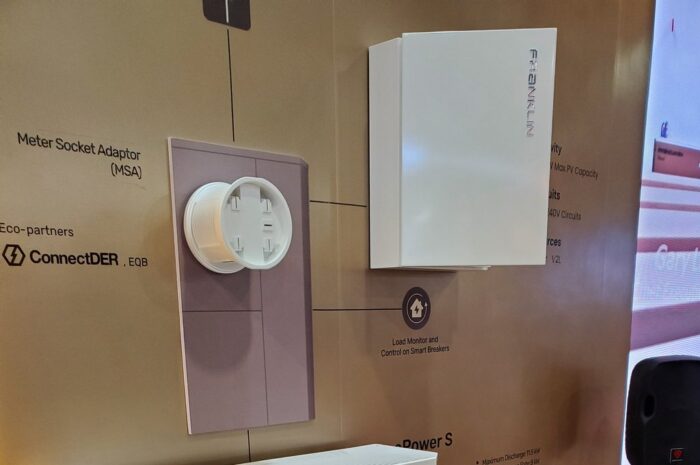
Residential solar in 2025 is no longer just about modules and inverters. Even “solar + storage” isn’t enough. The newest wave of product releases at RE+ are aimed at connecting rooftop solar with storage, EV chargers, smart load centers, and other energy management tools.
Two main strategies are emerging. Some manufacturers are building one-stop-shop portfolios, pulling every category under their own brand to simplify procurement and service. Others are doubling down on their core value proposition and leaning on partnerships, giving installers more flexibility in how they design systems.
Across both approaches, the trend lines are the same: fewer boxes, fewer connection points, and more intelligence. Smarter load management and integrated backup are increasingly being used to avoid costly main panel upgrades. That’s no small detail — nearly half of U.S. owner-occupied homes are more than 40 years old, and upgrading a main panel can run $5,000–$25,000. That’s a tough bill to swallow on its own, let alone when the residential solar tax credit sunsets in 2026. Keeping solar + storage system and installation costs low will be more crucial than ever.
Here’s everything new announced in the residential inverter + ESS + EV charger + energy management space coming out of RE+ 2025.
Expanding one-stop shops
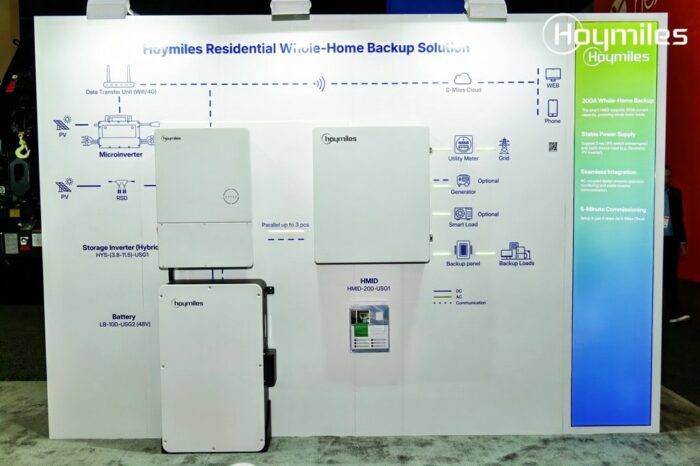
Hoymiles continues to streamline its solar + storage offering for installers from off-grid to whole home backup. Hoymiles comprehensive hybrid solution combines the HYS hybrid inverter, LB battery, and HMID meter-ready electrical panel. The HYS-(3.8–11.5) LV-USG1 hybrid inverter achieves up to 97.6% efficiency, while the LB-10D-USG2 battery provides 10.24 kWh capacity, scalable to 102.4 kWh for growing household needs. Completing the system, the HMID-200-USG1 breaker box ensures easy installation and enables uninterrupted power during outages.
The HIS-(15–20)L-USG3 series is a high-performance split-phase hybrid inverter with 15–20 kW power classes. Featuring 4 MPPTs with DC/AC oversizing up to 200%, it maximizes solar harvest under diverse conditions. The intelligent EMS supports multiple operation modes, while integrated AI management connects seamlessly with generators, heat pumps, and smart loads.
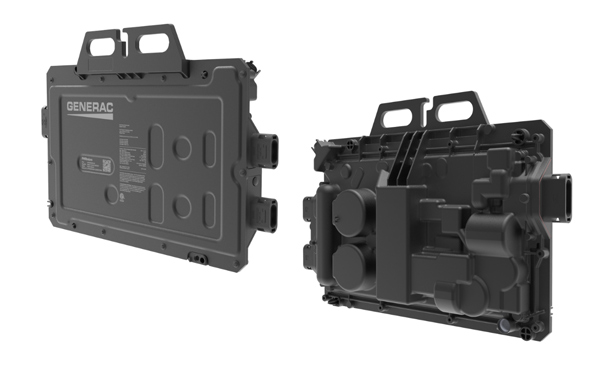
Generac expanded its solar + storage product ecosystem with long-awaited PWRmicro microinverter— a dual-input 820W that can handle today’s larger modules while cutting down on clipping losses. Generac originally acquired the Chilicon Power microinverter and software tech in July 2021. They’ve tinkered with the platform for several years and are now ready to push the PWRmicro to market. PWRmicro was developed with field crews in mind. The unit can be commissioned with Generac Field Pro, a mobile app that allows instant device discovery, nighttime commissioning using grid power, and faster troubleshooting with live data and automated self-tests. Firmware is pre-loaded and updated overnight, reducing setup time even further. Read more about it in “Generac launches dual-input 820W PWRmicro inverter for residential solar”
SolarEdge Technologies debuted the new SolarEdge Nexis System, which they are aiming at third-party ownership (TPO) models in the U.S. residential solar market where “financing, service, and scale are key.” Built on a modular LFP battery design and SolarEdge’s DC-coupled architecture, SolarEdge Nexis can be installed in under 15 minutes and commissioned in under 22 minutes, according to their promotional material.
“The residential solar market is evolving fast, and the Nexis solution is our response to what TPO providers have been asking for – more flexibility and operational simplicity at scale,” said Marty Rogers, General Manager, North America, SolarEdge. “Our DC-optimized technology generates more power and charges faster, which directly translates to better economics for our TPO partners and more savings for their customers.”
Initial units have already been pre-ordered by partners across the residential channel. General availability is expected in 2026.
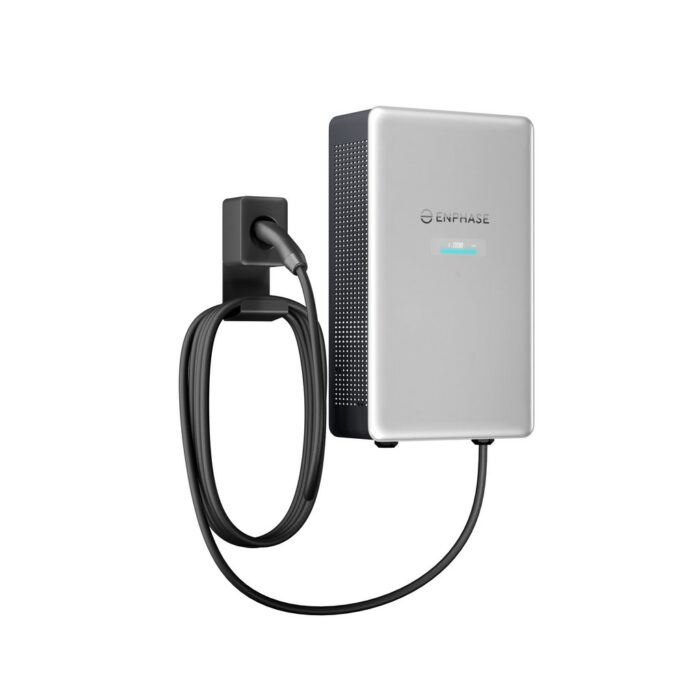
And, of course, Enphase Energy, Inc. is expanding its ecosystem in all directions. At RE+ 2025, Enphase showed off its new IQ Bidirectional EV Charger architecture for vehicle-to-home (V2H) and vehicle-to-grid (V2G) capability – but will not be available until the second half of 2026. The IQ Bidirectional EV Charger is targeted to support 400 V and 800 V EVs, and deliver up to 11.5 kW of bidirectional power.
“The IQ Bidirectional EV Charger brings the family car into the home energy system,” said Jayant Somani, senior vice president of the digital business unit at Enphase Energy. “It’s simple to install, easy to control, and designed to deliver backup power and the ability to share energy with the grid for homeowners.”
Bidirectional EV chargers come in two types: AC, which connect through the home’s wiring and rely on the vehicle’s onboard charger, and DC, which connect directly to the vehicle’s port for faster power transfer and smarter energy control. Enphase expects to offer both, with the IQ Bidirectional EV Charger using the DC design, with the inverter built into the charger rather than the car.
Webinar!
If you’d like to learn more about setting up Vehicle-to-Load, check out this upcoming Solar Builder webinar: Turning EVs into Home Energy Sources: Discover Vehicle-to-Load | Sept. 30 | 1 pm EST
The IQ Bidirectional EV Charger needs to be paired with the IQ Meter Collar. The IQ Meter Collar is a key component of the recently launched 4th-generation Enphase battery system alongside the IQ Battery 10C, and IQ Combiner 6C. The IQ Meter Collar delivers microgrid interconnection device (MID) functionality and energy consumption metering in a single enclosure, allowing for whole-home backup without rewiring loads to a backup sub-panel.
Speaking of meter collars …
Interconnection and load management
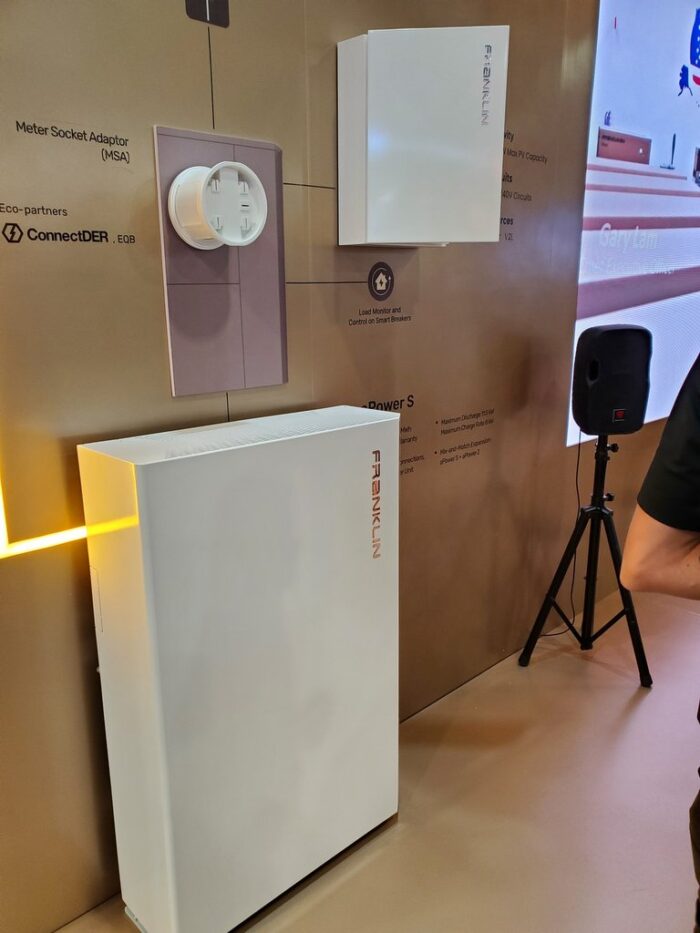
If you don’t want to be locked into one brand’s product line, ConnectDER is the meter collar for you. ConnectDER is a brand-agnostic plug-and-play meter socket adapters (MSAs) company. At RE+ 2025, ConnectDER debuted its next generation IslandDER. Installed in 15-30 minutes, IslandDER enables home backup by integrating, you guessed it, “islanding” functionality directly into the meter socket via a built-in Microgrid Interconnect Device (MID) and Consumption Current Transformers (CTs).
ConnectDER announced its compatibility with the following battery brands:
- SolarEdge Nexis Solution,
- FranklinWH’s aPower 2 and aPower S (pictured above)
- Lunar Energy’s Lunar System, and
- EcoFlow’s OCEAN Pro …
… with an additional 22 partnership agreements in place.
“The residential energy storage market is at a critical inflection point, but its full potential has been constrained as installers must choose between labor-intensive battery installations or locking their customers into a closed ecosystem,” said Ivo Steklac, ConnectDER’s President and CEO.
IslandDER joins ConnectDER’s lineup of installer-backed, field-proven MSAs including their Solar MSA and EV MSA. ConnectDER’s MSAs are currently approved in 44 utilities across 24 states with strong residential renewable energy adoption—reaching 50 million serviceable households nationwide. IslandDER™ has already been approved in multiple markets including an active pilot phase in California. IslandDER is expected to be available to purchase through distribution in Q4, 2025.

Koolbridge Energy showcased its new 125 Amp and 200 Amp SMART LOAD CENTERs. Koolbridge Energy recently rebranded from Koolbridge Solar to reflect its broader mission of managing all types of energy, not just solar. The new name aligns with the company’s commitment to intelligent power management across hybrid systems that combine both traditional and renewable sources.
These advanced intelligent breaker panels are designed to manage and optimize multiple energy sources — including grid, solar, battery, and generator — on a circuit-by-circuit basis. The SMART LOAD CENTERs can simultaneously control two incoming energy sources, featuring real-time switching and circuit-level prioritization. This functionality makes it ideal for homes powered by solar and battery storage, as well as other distributed energy resources (DERs).
New deals from battery specialists

Rolls Battery has a deal for NABCEP installers (and nifty app features). A battery system is only as good as the pros installing and maintaining them. This is why Rolls Battery has an offer for NABCEP certified installers interested in their new lithium battery stack. Go to them directly before Sept. 30 and get a great deal.
The S48-100LFP STACK-LV 51.2V 100Ah LiFePO4 DC ESS lithium battery is designed for 48-volt system integration and offers up to 40kWh energy storage in a modular, stackable format. The dual M8 threaded terminals and included busbars make for an easy connection and RS485 & CAN inverter connectivity. An onboard display & controls provides SOC, voltage, operating and alarm indication, and each unit includes a side-mounted secondary breaker for added safety. Designed for >6800 cycles at 80% DOD.
The Rolls app also eases commissioning monitoring.
- At commissioning, if you’ve selected one of their integrated inverter partners, you can easily select that inverter to dial in the right settings. Victron, Sol-Ark and EG4 are just a few examples the team rattled off at RE+ but there are many more.
- For monitoring, the app will pull data from the battery – and that incidence log file will go directly to Rolls, to help correct any errors as soon as possible.
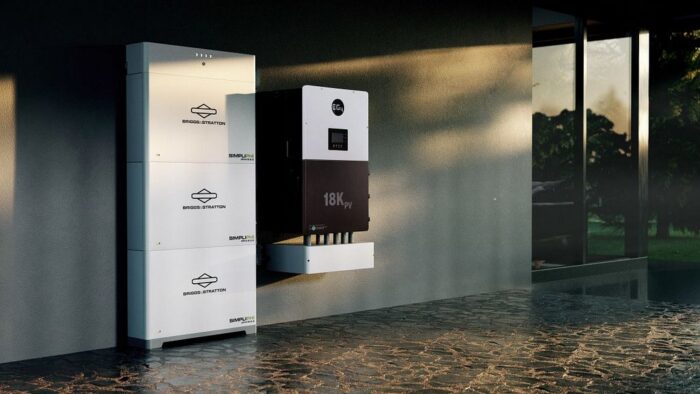
Briggs & Stratton & EG4 Package options | Briggs & Stratton is firmly in the specialist category. After acquiring the SimpliPHI battery technology, they have continued to simpli-fy the battery stack and expand partnerships with established inverter brands. The latest: Briggs & Stratton SimpliPHI 6.6 batteries and PowerProtect standby generators now integrate with EG4 inverters.
Briggs & Stratton’s new lineup of Battery Backup Packages feature the company’s SimpliPHI 6.6 stackable batteries paired with EG4 Inverters, providing an easy way for installers to meet customers’ power needs with Essential Power, Managed Power and Whole Home Power options.
The Briggs & Stratton battery packages integrate with EG4’s 12KPV and 18KPV all-in-one hybrid inverters. Briggs & Stratton batteries and generators also integrate with FlexBOSS18 and FlexBOSS21 hybrid inverters and the GridBOSS microgrid interconnect device (MID), which pairs with the FlexBOSS line of inverters. The full closed-loop integration for advanced communication with all EG4 inverters makes commissioning and operation smoother and more efficient.
The EG4 FlexBOSS21, FlexBOSS18 and 18KPV inverters are also EMP-hardened, ensuring reliable performance during Electromagnetic Pulse (EMP) events.
The package concept centers on how much of the home the user wants to power during an outage – from 50% of a home’s normal energy usage to 100%, which allows the homeowner to power everything in their home for a period of time. While the packages recommend a starting number of batteries, they are scalable, and all come with a 200A pass-thru for easy integration into most homes’ main service panel. Given a home’s average energy use ..
- a one-battery system with an EG4 12PV inverter delivers 10.8 hours at 50% backup load.
- a two-battery system with an EG4 18PV inverter delivers 14.5 hours at 75% backup load
- a three-battery system with an EG4 18PV inverter delivers 16.4 hours at 100% backup load.
For larger installations, the battery system can be scaled up to 18 batteries, delivering 119.7 kWh with maximum continuous power of 84 kW or 90 hours of power at 100% load.
Speaking of EG4 …
New Inverters and MLPE
EG4 Electronics has agreed to produce Tigo optimized inverters and MLPE together with EG4 solar inverters in the United States of America. Solar installers in the U.S. currently already pair inverters from EG4 with Tigo MLPE devices, which have been certified as compatible. In March 2025, EG4 Electronics’ parent company, Energy Access Innovations (EAI), announced the acquisition of a state-of-the-art 310,000 sq. ft. manufacturing facility in Commerce, Texas.
“We believe in energy autonomy for our customers just as much as we believe in manufacturing autonomy for American innovators, and this partnership with Tigo allows us to make significant progress on both of those fronts,” said James Showalter, founder at EG4 Electronics. “This partnership with Tigo is exactly the kind of arrangement we had in mind when we announced our new manufacturing facility earlier this year. We look forward to building American-made energy infrastructure together with Tigo.”
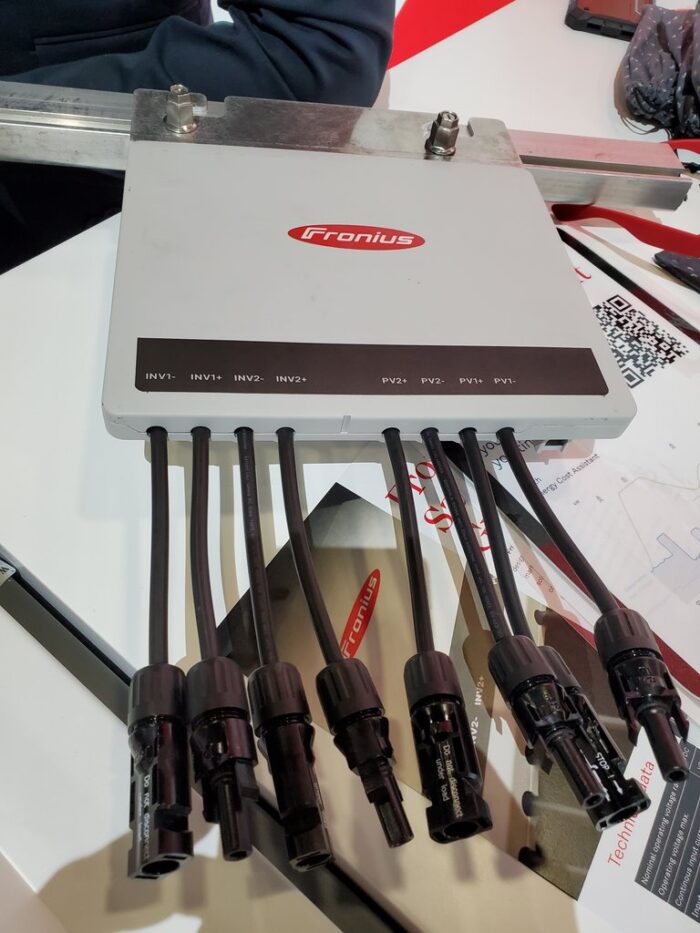
This is just an early look, but soon you’ll be able to order a Fronius-built rapid shutdown device just like this to pair with your Fronius inverters.
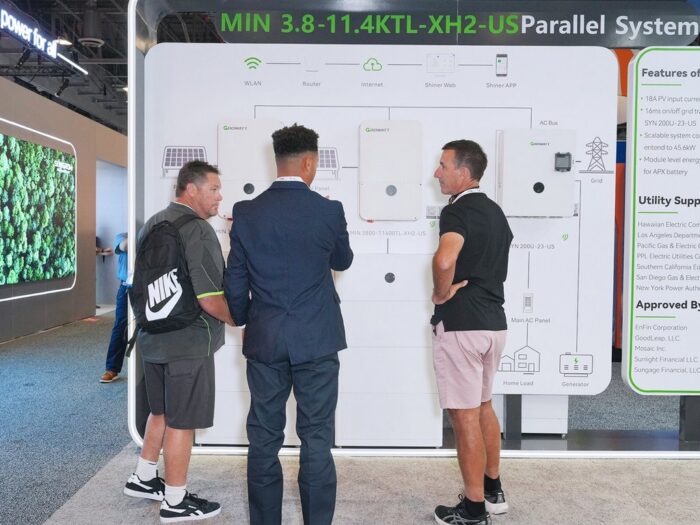
At the center of Growatt‘s residential showcase was the MIN 3.8–11.4KTL-XH2-US, the company’s next-generation single-phase hybrid inverter tailored for the U.S. market with a power range from 3.8kW to 11.4 kW. The system supports high-voltage batteries and integrates with both Growatt and third-party storage solutions. When paired with SYN 200U-23-US accessory, the MIN XH2-US can support up to three units for off-grid parallel operation, giving households greater scalability to power more loads and ensure reliable backup. For larger households and light commercial users, Growatt presented the SPH 12000–18000TL-HU-US(B), a split-phase hybrid inverter that provides 12kW to 18kW scalable power. This system enables seamless integration of PV, storage, and backup power, ensuring users benefit from peak shaving, load shifting, and blackout protection



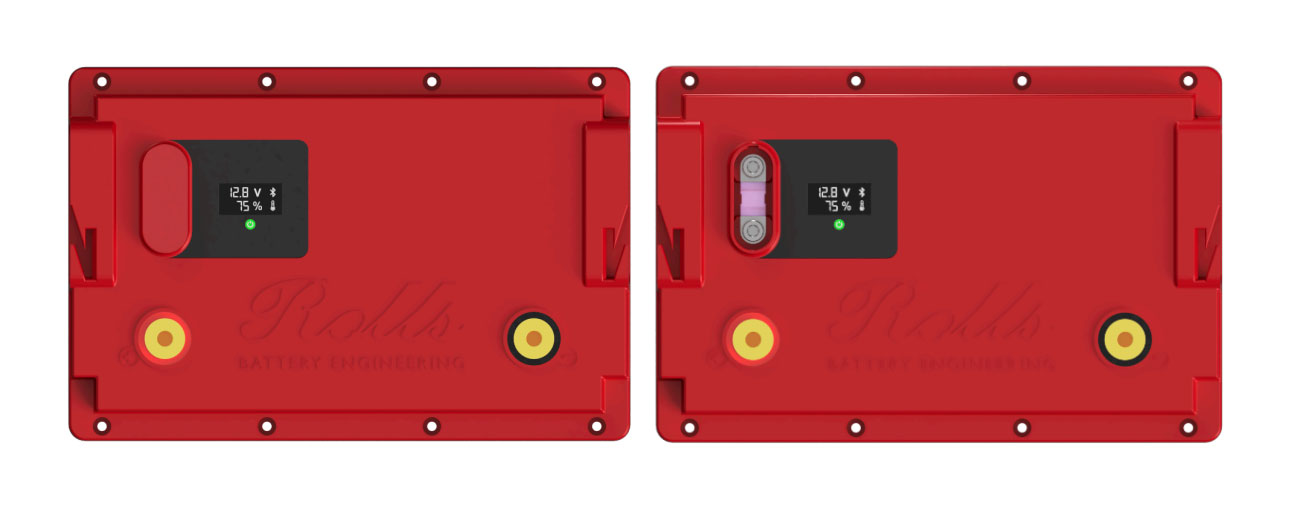

Comments are closed here.